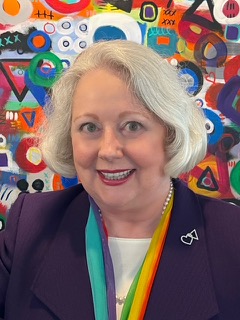Why Pride Should Be a Year-Round Effort
By Jaron M. Terry, M.S., APR, Fellow PRSA
August 2024
Now that another Pride Month is in the books, let’s talk about why Pride celebrations should not be relegated to a single month, when we really need to lift people who identify as LGBTQ+ the other 11 months, too.
Pride is important year-round because — although some rights are won — there is still work to be done. As long as we continue to see legislation proposed and enacted specifically limiting the rights and freedoms of LGBTQ+ individuals — in particular seeking to exclude from public places those who are transgender or who identify as nonbinary — the need for continuous recognition of Pride and intentional inclusion of LGBTQ+ people remains strong.
Organizations can create year-round LGBTQ+ inclusion.
When I hear people ask why Pride Month is needed, it’s clear that either education is lacking, or in a few cases, perhaps willful bigotry is present.
Education starts with teaching what LGBTQ+ stands for beyond individual letters: Lesbian, Gay, Bisexual, Transgender, Queer, and Plus, and in understanding that sexual orientation and gender identity — human characteristics we all possess — are each on a spectrum rather than being binary.
According to PFLAG National’s Glossary, the letter Q stands for a word reclaimed with pride from earlier negative use and today simply means that a person who identifies as queer is neither straight nor cisgender. The plus (+) sign acknowledges that we don’t leave out the people who exist along the spectrums.
Building LGBTQ+ workplace inclusion beyond Pride Month requires a year-round focus on diversity, equity, inclusion — and belonging. DEI is important in workplace settings because teams lacking diversity and inclusion risk insular thinking that limits the innovation, creativity, and counsel PR and communications practitioners offer employers, clients and customers.
Equity is a human rights issue, as is belonging, which enriches individuals and engenders trust and openness among team members. Research into workplace cultures shows the cost of employees who feel they cannot bring their whole selves to work due to discrimination in the form of harassment, intimidation, or exclusion from meaningful work projects, can be quantified in lost worktime, burnout and high turnover rates.
When organizations capitalize on the focus and energy that comes from people being fully present and fully contributing, it’s a win-win for everyone. This is true not just for members of the LGBTQ+ community but for all marginalized groups.
Best practices for year-round LGBTQ+ inclusion involve providing organizational competency training to help uncover and address unconscious — or implicit — biases against people some see as “other.” The Human Rights Campaign Foundation’s Corporate Equality Index lists several recommendations, including electronic data collection forms that allow employees to self-identify gender beyond male/female and to require all employees to denote their pronouns in email signatures.
Best practices also include using appropriate terminology in written and spoken communications, as well as understanding that sexual orientation and gender identity are not the same thing.
Young adults show their support.
It shouldn’t be surprising that more and more young people identify as members of the LGBTQ+ community. In 2024, Gallup reports that younger generations are nearly twice as likely as those who go before them to identify as LGBTQ+. Of Gen Z adults (born 1997-2012), more than 22% say they are LGBTQ+, with nearly 10% of millennials (born 1981-1996) reporting the same. Therefore, it behooves organizations to implement best practices that build and support inclusive workplaces.
Today’s young professionals — LGBTQ+ and straight/cisgender alike — aren’t strangers to speaking up for what they want in their workplace. Forbes recently reported a Monster poll indicating that 83% of Gen Z respondents decide where to bring their talents, skills, and time based on an employer’s commitment to diversity and inclusion.
Most young professionals have the courage and passion to call out injustices they experience, witness or hear of. Employers who care about recruitment and retention will do well to understand that when young professionals don’t feel fully seen, appreciated and included they will not stick around.
DEI programs still have allies.
I’m concerned about DEI’s downward trend in recent months, with many corporations, organizations and institutions of higher learning putting it on the chopping block. I would like to think that fatigue, repetition or lack of budget are reasons for DEI’s downsizing. However, lack of leadership support, lack of courage in the current political environment, and — in some cases — bigotry and racism are root causes.
The contraction of women’s rights, including agency over their own bodies, the contraction of parental rights in caring for their transgender children, and the contraction of students’ rights to learn history and science, is very distressing.
However, I am heartened that CNN recently reported Pew data that finds most employed Americans say increasing DEI is a good thing and I agree with the USC Race and Equity Center that corporate leaders who dismantle DEI programs risk creating a hostile work environment.
I’m also concerned about AI’s potential negative impacts. When discriminatory biases are in data used to machine-train large learning models that interpret human language, culture, and complex concepts, AI systems may perpetuate and amplify prejudices. This potential danger, compounded by ethical questions about transparency, accountability and responsibility, must be consciously mitigated by human intervention.
It’s imperative that LGBTQ+ people — transgender children in particular — hear affirming voices against hatred and bigotry. That’s why I continue to lead with love, using my PR and communications skills to fight for the rights of LGBTQ+ persons and let them know they belong — 24/7, 365 days a year.



